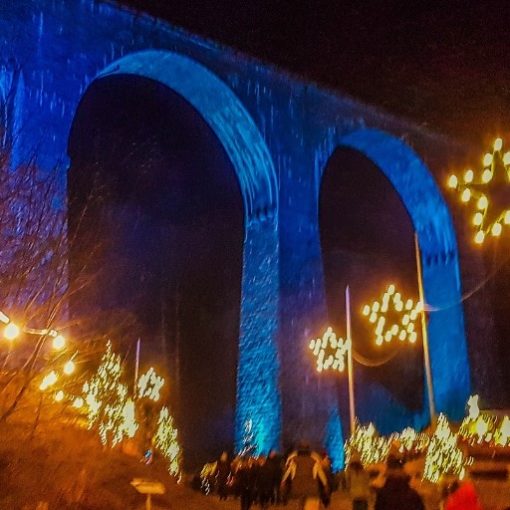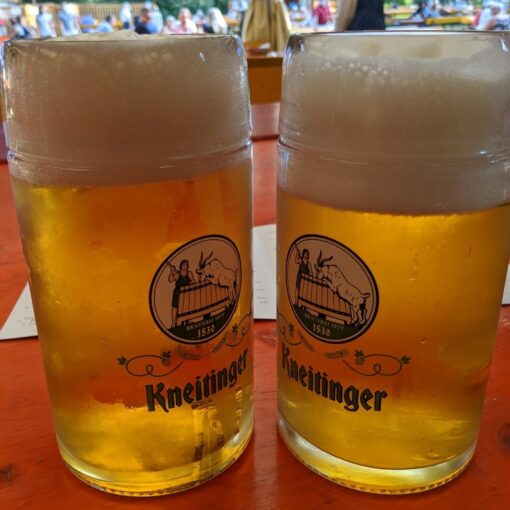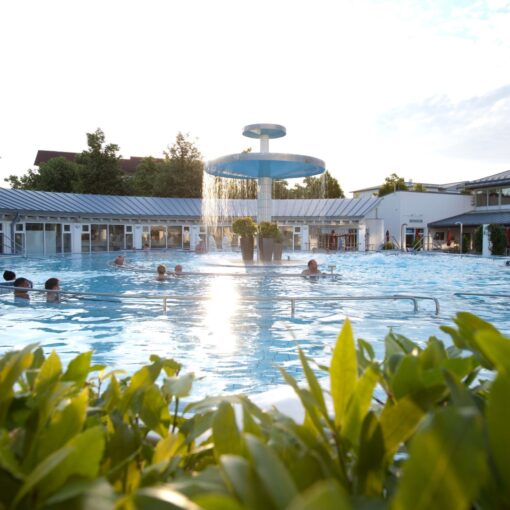What’s the first thing you think of when I say, “Germany?” For many people, their next thought is, “BEER!” After all, Germany is home to the largest beer festival (Oktoberfest anyone??) in the world! So it’s no surprise that the history of beer in Germany goes back for centuries. There are many different ways to step back in time in Germany. From going to any of the countless ruined castles to diving into WWII history, or simply enjoying a beer. All of these are examples of how to peer back into the yester-years of Germany. And if you are looking for the history of beer, look no further than the Bamberg Rauchbier (Smoked Beer).
Oh, German Rauchbier (German Smoked Beer) – this one is NOT for the faint of heart! I always say that you’ll either love it or you’ll hate it. And there is no better place to experience this beverage than to try an authentic Bamberg smoked beer in Bamberg itself- home of one of the only two continuously operational breweries still making authentic Rauchbier in the world!
You'll Find In This Article:
Rauchbier: It’s Not For Everyone
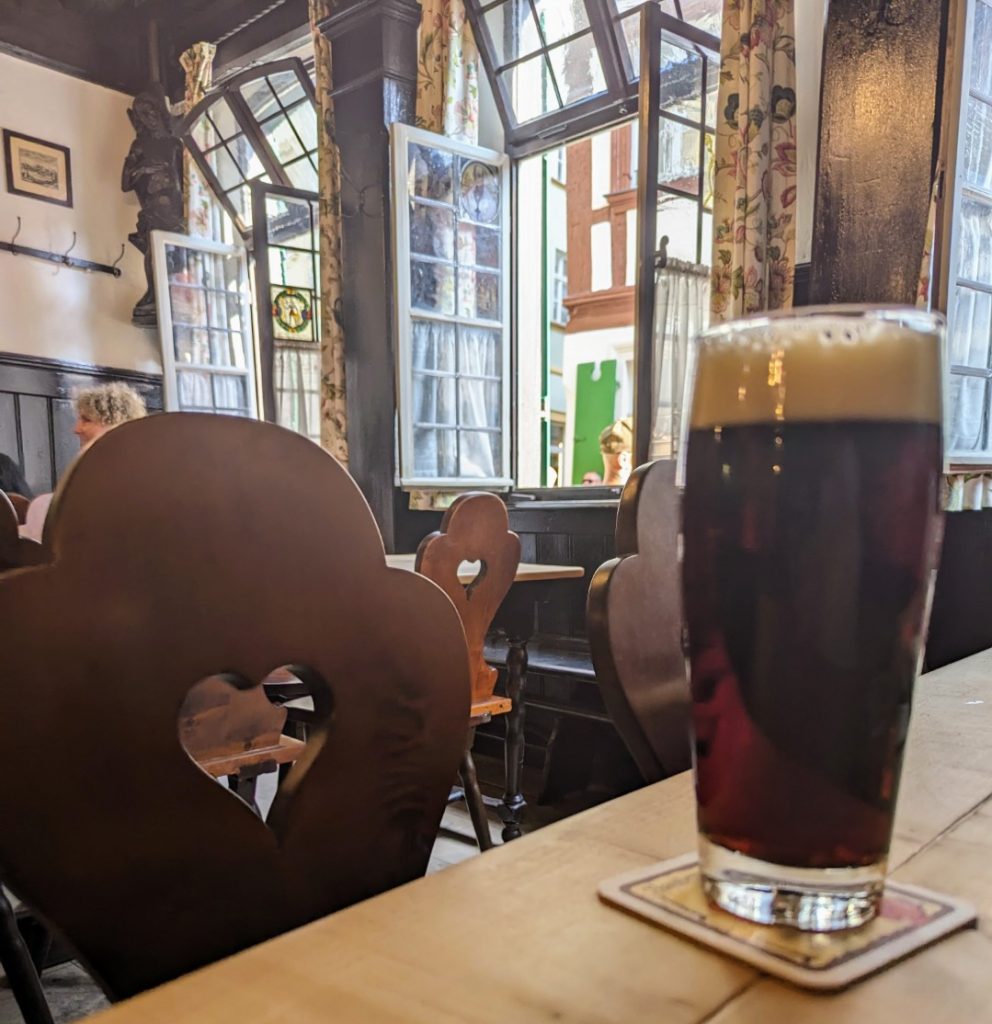
Once a Raucbier is poured into the glass (NEVER drink it straight from the bottle!), I dare you to smell it. That alone is going to pack a punch. While many German, dark beers may have a chocolate, caramel, or roasted smell, a true Rauchbier will be….well, let’s just call it “more intense” with its aroma profiles (and by profiles, I mean IN YOUR FACE smoke smell!)
As you hold up your glass to the light, the Amber colors will begin to really shine and you’ll begin to see hues of reds.
It’s all a bit confusing. It looks like a dark beer, but it won’t actually taste like one. Even the foam on the top is darker in color than a typical lager due to the smoke.
You take another whiff because, well, this is just weird. I mean, we know it’s a smoked beer, so we should be expecting smoky aromas right? But wow! You weren’t expecting to feel like you are sitting right next to a blazing campfire getting hit in the face with a waft of smoke!
Your senses are already a bit discombobulated, but you tilt the glass up to your lips. Bacon. BBQ. Campfires. No wonder Bamberg calls Rauchbier “Schinkin zum Trinken” (Ham to drink!)
Now, after reading all this, you may be saying, “Oh, My Gosh! LeAnna!!! Bacon flavored beer!!!??? That’s my dream come true!” And all I have to say is “you might be surprised” (and not in a good way). I’m obsessed with bacon just as much as the next Ron Swanson lover, but Rauchbier truly is….something else! But, just like anything in life, it’s truly something you just have to try for yourself to experience! I don’t care how many beers you’ve had in your life. an authentic Rauchbier is truly a flavor experience you have probably never had. And it is certainly an experience you won’t forget!
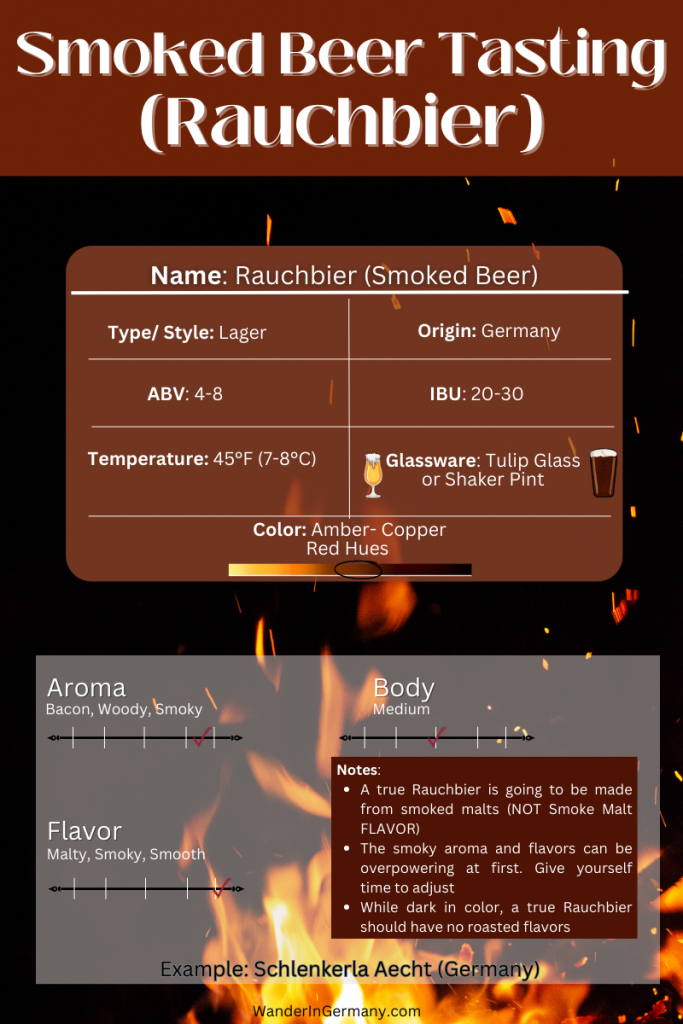
Now that we know a little of what to expect in how a smoked beer tastes, let’s dive into the history of it, where to find a traditional, German Rauchbier and more.
The First Beers Made
Let’s travel back in time….like waaaaay back. Many scholars believe that beer production started as early as 6,000 years ago (Some people even think it could be upwards of 12,000 years ago!) And there are reports that as far back as 800-600 B.C, ancient people in what is today Germany/ Austria were already doing some home-brews. I mean, no wonder Germany is known for its beer! They’ve had over 2,500 years of refining their skills!!!
Now, we know that the ancient people weren’t just purposefully brewing up drinks to get drunk around their campfires. Instead, it was when cultivation of the lands started that they realized how to use grains for nutrition. Of course, I can’t say for certain what Klaus the Caveman was using exactly in his beers, but generally speaking, most beers are made with Malt.
The problem with malt products though is that in order for it to actually be easily digested for nutritional purposes, it must first be soaked. Well, when something gets wet, it then must be dried.
Enter: FIRE!
All Beers Were Smoked Beers!
Ok, so for the purpose of learning about smoke beer, you probably see where I’m going with this.
Yup, you figured it out. It’s highly, highly probable that some of the first beers ever consumed were actually on some spectrum of a smoked beer. After all, when they dried the malt by fire, the smoke inadvertently would flavor the malt, which would then affect the final taste of the beer.
So for upwards of several MILLENNIA the world most likely ONLY knew smoked beers! It actually wasn’t until very very recently (historically speaking) that we got the beers that we know today (but more on that in a little bit below…)
Fun Fact: Most beers used to be dark beers. Due to the grains being harvested in the fall, most likely, beer was most commonly brewed in the winter. Now, I won’t get into all the scientific parts of the brewing (mostly because I actually don’t know all the ins and outs myself… I just like drinking the stuff!) but there is a stage of the process called “Mashing” and in the winter with cooler weathers, it was safer to leave the malt in this stage longer…resulting in darker beers.
Beer Was Safer Than Water
Alright, so let’s fast forward in the history text books to the Middle Ages, where beer was often one of the safest drinks to consume. After all, there were no water treatment plants and we all know how diseases ran rampant through villages. Many people were making their own beers in medieval Europe because it was safer to drink alcohol than water. But then came the monks.
I often simultaneously laugh but also swear that German beers made by monks really are the best beers. Maybe it’s because they had plenty of free time on their hands to play around with recipes in the wee early years of the 700s or the little known fact that monks totally skirted the system and found loopholes to the rules of fasting. No matter the reason, monks actually did change the game when it came to beer in the Middle Ages in Europe.
Not only did monks have plenty of time in their solitude, but many also fancied science, allowing them to experiment. But, arguably, one of the biggest reasons for monks taking on the task of mastering the brews was a bit of a self serving one. After all, monks often had to fast (particularly for long periods during Lent) buuuut those clever guys found a loop hole! “Liquid does not break a fast.” Combine this knowledge with that idea we mentioned previously about how grains provide nutrition and VOILA! Those sly monks now had their “Liquid Bread” to sustain them during periods of fasting (can you even imagine drinking high alcohol, dark beers on an empty stomach! Makes me wonder what kind of ragers those medieval monks were having!)
Since this was their sole sustenance at times, they obviously took a serious interest in making it reeeeaaaaally good. So good that locals began wanting in on the action. Eventually, monastic breweries began popping up all over Germany where they could then sell their beers to the commoners.
So let’s circle back now to the Smoked Beer, shall we? During all this evolution of mastering beer production, one thing still remained true. You needed to dry the malt to prevent it from spoiling, which meant that aaaaaall this time, most of these beers being made were all (yup, you guessed it) SMOKED BEERS! (In full disclosure, obviously, other methods eventually were used which included things like straw (which would still omit certain amounts of smoke) and coal. But at least in Germany, wood remained the main preference for creating a fire to dry the malt).
Obviously, the level of smoke (flavor) could vary. In fact, it often DID vary even from batch to batch even with the same brewer. However, one thing that people easily discovered was that the less smoke you put on the grains, obviously the lesser smoke flavor in the final product (although, when talking about open fires, there almost was always going to be SOME level of smoky smoky beer)
Side Bar: In 1516, the official “Beer Purity Law” (the Reinheitsgebot) was enacted to declare that ONLY 3 ingredients may be used in beer.
- Water
- Barley (Malt)
- Hops
- (Yeast was later added to satisfy the semantics of it all even though traditionally, yeast was still used, but since it naturally fermented, that is why it wasn’t on the official list)
In fact, the Reinheitsgebot STILL exists today, particularly in Bavaria!
New Inventions= New Beer Styles
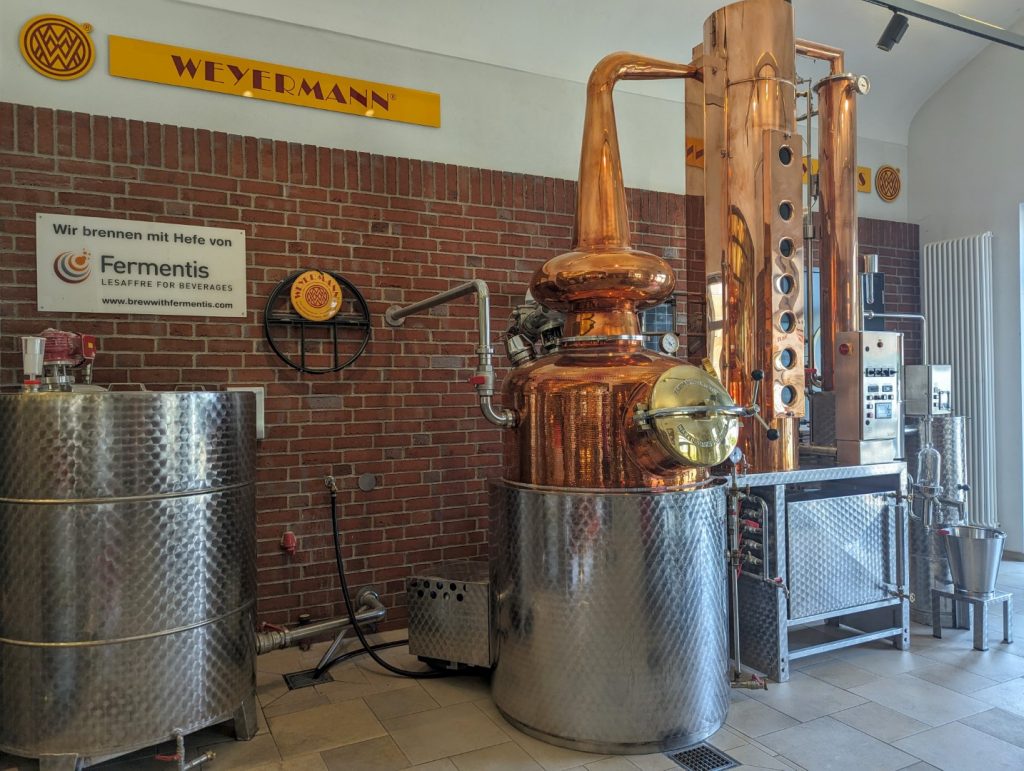
Ok, so now that we understand the history of beer, and therefore, the history of Rauchbier, let’s continue moving forward in time to the Industrial Revolution, being spearheaded by Great Britain. While TODAY Germans are world-renowned for their beer, this wasn’t always the case. It was England that was making waves in the beer scene. The English Malt Kin (a new way of drying malt) had actually already been used for a little while in Great Britain before Germany ran with the idea. Inspired by a coffee roaster, British inventor Daniel Wheeler saw that the beans were being roasted by indirect heat. He applied the rotating drum technique to an earlier iteration of another “English Kiln” and quickly saw the power and potential of roasting malt without direct access to the fire (and consequently smoke).
Then, in the 1830s, the son of a Munich Brewer just knew that there were ways waiting to be discovered to revolutionize the beer industry as we know it. As a young, wealthy, brewer himself, Gabriel Sedlmary (II) headed off to England to do some serious recon of what they were doing to make their own beers at the time. Some even go so far as to dramatically call it “Industrial Espionage.” Regardless, let’s just say that Gabriel hit on gold and returned with several great ideas, one being to start using the English Malt Kiln at his own brewery. He made some tweaks to some recipes butt now, with the use of this much easier and much more predictable tool for roasting malt, he was able to create the (now famous) Munich Märzen (AKA Oktoberfest Style) However, to fully understand exactly how he did this, it would take us down an incredibly wild and deep rabbit hole. Let’s just sum this part of the story up by simply saying that Gabriel Sedlmary put not only his brewery (Spaten) on the map, but Germany’s new, easy to make (and let’s not lie…delicious) beer (Lager) spread like wildfire thanks to him.
Fun Fact: Seldmayr was so forward thinking that it’s reported that the first ever “modern refrigerator” was actually used at the Spaten Brewery. So next time you open up your fridge at home, thank the founding father of modern day German beer!
Smoked Beer Became a Thing of the Past
But let’s circle back to the Rauchbier, shall we? One thing I personally began to wonder when I first learned about all this when I had my first sips of the smoked Bamberg beer was “If modern beer as we know it (lagers, ales, etc) has only been around for (give or take) 170ish years, why isn’t SMOKE BEER still more common/popular today?” I mean, especially with all the movements with craft breweries, particularly in the States, and how much modern day brewers just love playing with flavor profiles, I am legit shocked that it either hasn’t made a resurgence or that it just simply didn’t hang around from before the 1800s.
Basically, it came down to several facts that:
Using Fire to Dry Malt Was:
1) Not a very (easily) controlled method- therefore hard to scale, predict, etc
2) Limiting: drying malt by fire/smoke really only left a few styles of beer even able to be produced
3) Expensive: If someone was using the smoke as a flavor profile, they needed high quality wood
4) A giant fire hazard!
Because of these reasons, it’s easy to see why smoking beer just was no longer feasible, practical, safe, and financially smart for large scale producers. And so….Rauchbier Became a Thing of the Past. Except for the (now historical)…..
Traditional Bamberg Beer (Bamberger Rauchbier)
While basically ALL the smoked beer breweries fell to the waste side (or converted to the English Kiln method for drying malts), one small town in upper Bavaria in the region of Franconia held on strong. When almost all towns, villages, and breweries moved on, Bamberg somehow held on to this traditional way of making beer when seemingly EVERYONE else in the world jumped ship (or in the case, Kiln) for the new ways of brewing. Even today, Bamberg has the only breweries in the world that have continuously made authentic and traditional smoke beer. That’s why today Bamberg and Smokebeer could not be more synonymous!
Why Bamberg Held Onto Smoked Beer
Germans Being Stubborn and Old School?
Ok, this is my own personal conspiracy theory, but (very stereotypically speaking) some may argue that Germans can be a bit….well, headstrong (maybe that’s where I get my stubborn streak from! It’s in my DNA!) And having lived in Germany now for upwards of 10 years I can tell you that, as a whole, German society can be a bit “traditional” in its ways and (this is simply a sweeping statement) not always willing to stay ahead of the times (in certain areas!) This is great for preserving the past but not so fantastic for wanting to think outside the box and encourage creative or independent thinking. But, obviously, this is not a hard and fast stereotype, especially considering that the different approaches, ingenuity, and thinking outside the box of beer brewing by the Spital Brewery is exactly what has allowed us to have beer as we know it today.
All that to say that while other breweries around the country were moving quickly to the “New is better” kiln, it is obvious that many Franconian brewers still found importance in continuing to pass down a “Traditional” beer production method. They did not want to let go of what they knew. Many decided that instead of going large scale, that it was still ok to stay smaller (since smoking beer is definitely more expensive) and instead of ramping up, they decided to put an importance on continuing to use quality ingredients, even if it meant having to stay small. But for many in this region, where the beer culture and traditions were strong- they knew that by doing this and remaining true with quality ingredients, that it would always result in good quality beer.
There Was No Good Supply of Coal vs Easy Access to Beachwood
When the Malt Kiln took off, the main fuel supply was coal. This prevented a problem for Bamberg, Germany breweries who really had no natural supply of coal mines nearby. HOWEVER, they did have one of Germany’s largest Beechwood Forests just to the West, which provided excellent, high quality wood for smoking! Since it actually would have been harder for the Bamberg Breweries to get coal, they decided to just keep on keepin’ on with what was already working for them!
Rauchbier Bamberg Breweries Today
Today, there are over 70 breweries in the Bamberg area!!! In fact, Bamberg supposedly has the most breweries per capita in the world! Despite Bamberg Rauchbier being pretty famous today, when the non smoke kilns eventually did make their way into the local breweries, it did not take long for it to sweep through the town as the preferred method. In just about 50 years, ALL but 4 Bamberg Breweries decided to move away from smoking beers. However, WWII brought the closing of 2 of those breweries leaving just two, which actually still stand strong even today. But if you are looking for the only place in the world that has been doing smoked beer continuously since the medieval ages, then heading to Bamberg is the place to be!
Schlenkerla Brewery
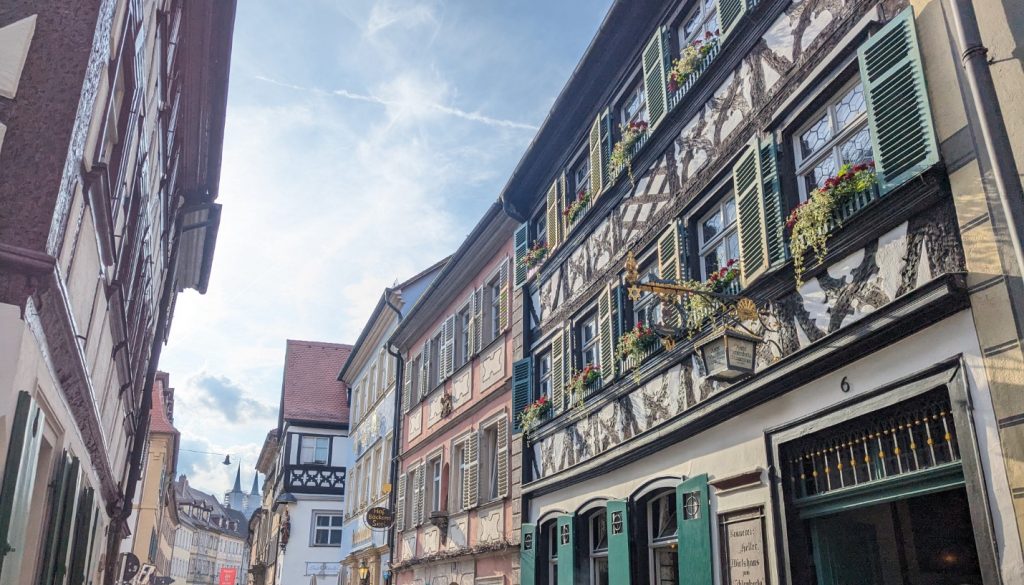
Located smack dab in the heart of the Bamberg Innenstadt, you simply can’t miss the home of the Schlenkerla Smokebeer! It is one of the two only surviving continuously brewing places in town with their Aecht Schlenkerla Rauchbier (Aecht Beer meaning “Traditional/Original/Genuine in Bayerisch). Many people consider it one of the best breweries in Germany and no Bamberg Beer Guide would be complete without it. In fact, they still use brewing and even tapping traditions that date back to the 1300s! Schlenkerla still prides itself on using the highest quality ingredients, including high quality beechwood for the smoking. Because of this, they have remained a small, but powerful German Brewery. While the big producers (think Spaten, Hofbrau, etc) may produce millions of barrels of beer a year, Schlenkerla keeps it small at around 20,000 barrels, ensuring high quality in every batch!
When you go get a Schlenkerla smoked beer, you can enjoy it outside in their lovely, shaded Biergarten, inside the wonderful, traditional style restaurant, or do as the locals do, which is to go inside, find the little window, order yourself and your friends a beer and then go hang out on the pedestrian street outside!
Famous Schlenkerla Beers to Try:
The Schlenkerla Märzen: Arguably, the most famous, or at least the most traditional of all the Schlenkerla smoked beers is their Märzen. A German classic Märzen is a lager, but because of the smoked malt, this bottom fermented lager is very dark in color. Even the foam is darker than most! When you hold the glass of beer against some light, you’ll even see bits of red tints. The Schlenkerla Märzen Rauchbier is made with 100% smoke malt, giving it that very distinct color and even MORE distinct flavors! Despite it being exceptionally dark, don’t expect the same profile flavors of your typical (roasted) dark beers. And yes, the smoke flavor is VERY prominent, almost a bit spicy. To continue to add to the flavors, this Aecht Schlenkerla Rauchbier is even kept in Oakwood casks and tapped according to old traditions.
- Very smoky smell and flavor (somewhat overpowering if you are not used to it)
- 5.1% Alcohol
- Best to try at least once!
Rauchweizen: Classic, German wheat beer (Weizen) meets classic, Bamberg smoked beer! You get a little of the wheat and you get a little bit of the smoke! This cloudy beer is top fermented in the bottle, but like most smoke beers, it’s best enjoyed out of a wider mouthed glass.
- 5.2% Alcohol
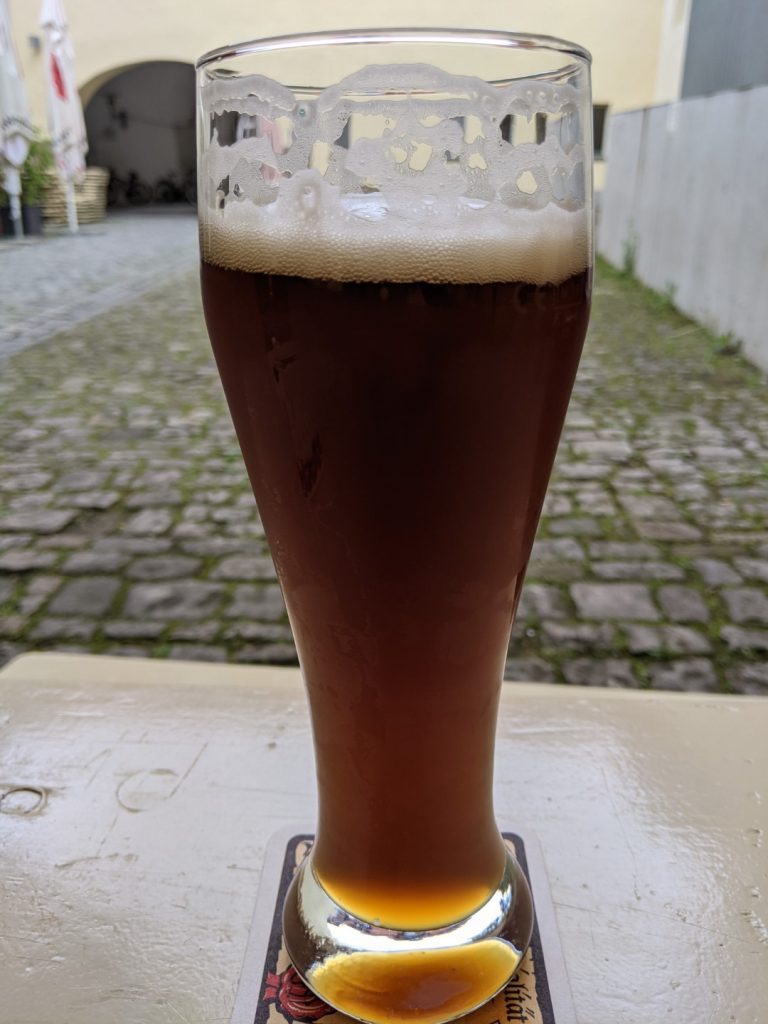
Helles Lager: If you want to delicately dip your toes into a Bamberg Rauchbier without being completely subdued by the smoke scent and flavors, then trying their Helles Lager is a good starting point for a more mild version. Still made with smoked malt, it’s just not as overpowering as the other classic styles.
- Good for “Beginner” Rauchbier drinkers
- 4.3% Alcohol
Schlenkerla Urbock: If there is anyone who knows how to do “Traditional” Beer, it’s obviously Schlenkerla and what is more traditional than a classic “Bockbieranstiche” or traditional “Bock Beer Tapping.” This seasonal Schlenkerla beer is made especially for the “Strong Beer Season” and each October, it’s a big deal when they celebrate tapping into the barrels. The Urbock is similar to the classic Märzen but with even more alcohol and even MORE smoke profiles!
- Seasonal beer for Autumn- December (can get it bottled through January)
- 6.5% Alcohol
Schlenkerla Doppelbock: Go big or go home with this one! This powerhouse (double) bock beer is also a seasonal beer and one that will surely pack a punch. What makes this one quite unique is that instead of the usual beechwood for the classic Schlenkerla smoked beer, this doppelbock uses a special oak wood to smoke the malt that goes into this brew. While the usual Rauchbier has a bit more “spice” to it, the doppelbock is typically described as smoother but yes, still smokey (albeit maybe not AS smokey as the Maerzen)
- Winter Seasonal Beer
- 8.0% Alcohol
Spezial-Keller
While Schlenkerla may be in the heart of the Bamberg Old Town, the Bamberg Spezial Brewery is where you should go for great views OF the Bamberg Altstadt! Oh, and for great Rauchbiers, too obviously! The Spezial-Keller and the Schlenkerla Brewery are the only 2 in Bamberg that still tout the bragging rights of “historically brewing smoke beer continuously.”
You’ll probably get a more “local” vibe and feel when you go “Auf den Keller” at the Spezial, which is how the locals would say “On the Cellars.” After all, originally the local Bamberg breweries realized that the natural caves in the area made for fantastic cellars that could keep beer barrels cool in warm summer months. Instead of having to “Roll out the barrels” (Cue Polka Song Singing!) they got people to come to them and sit on top of the cool cellars, hence the “Auf den Keller” saying.
If the very bold, in your face characteristics of the strong smoke style of the Schlenkerla Rauchbier was too much for you, then definitely give the more mild Bamberg smoked beer flavor at the Spezial Brewery a try to still get that authentic and traditional smoke beer experience without the intense backlash of the strong smoke experience. In fact, one way to make it easier on the palate to start with is the fact that the Spezial Kellar often has beers that are not just fully smoked, but more of a “blend” of a “normal” beer with a smoked one.
Spezial Keller Rauchbiers to Try:
“A Seidla” (HALF LITER) Lagerbier: Mild smoke flavors
House Made Smoked Radler: Radlers are such a refreshing summer drink in Germany. Pair it with Spezial’s special smoked beer for a unique experience.
Tips For Drinking A Smoked Beer
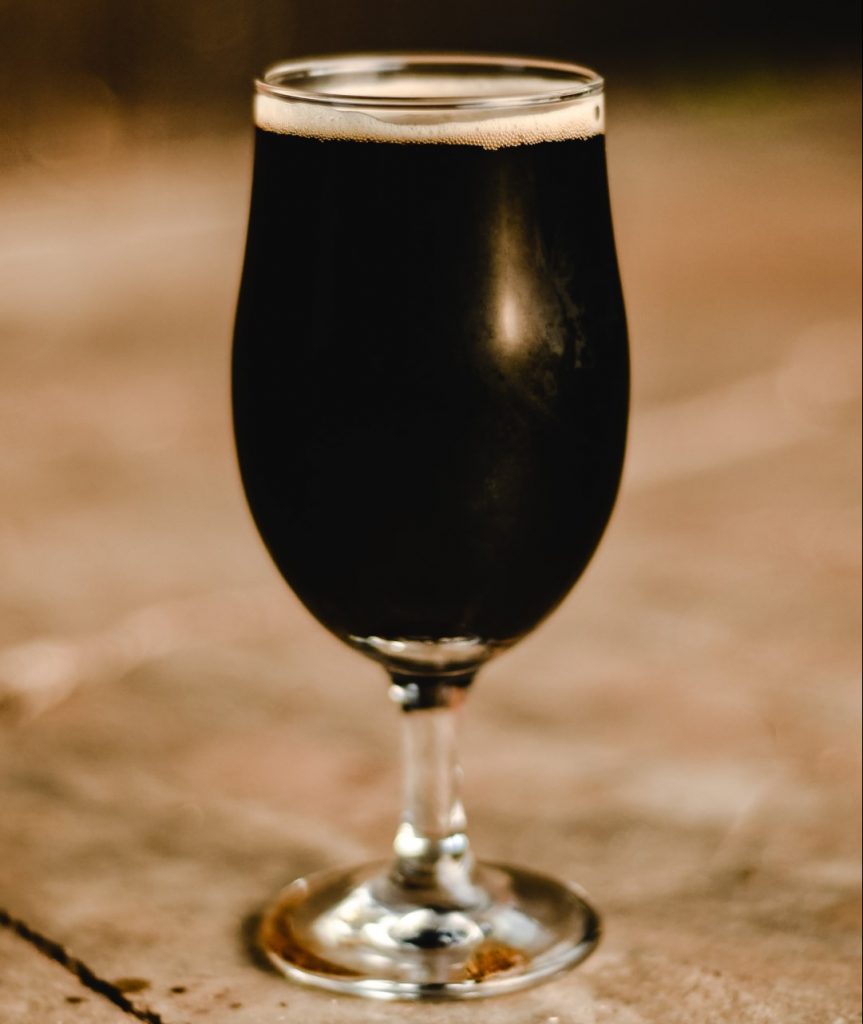
While at the end of the day, some people are just never going to come over to “Team Rauchbier” because of its pretty intense and bold flavors, there are actually a few ways to help enjoy it more, and surprisingly, there are even some “techniques” to the whole process (kind of like when the hoity toity people do a whole rigamarole when drinking wine)
Rauchbier Should Have a Good Head
While I’m no expert in the science of brewing, apparently, the foam on the beer is pretty important to help with aromatics. And when we are talking about such a strong smell as smoke it becomes obvious why having a good head to bring out that smoke smell is ideal. So, if you are pouring your own glass, be sure to let it have a decent amount of foam at the top. In fact, you should allow for about one quarter of the glass to have a head on it! So yes, you may need to pour quickly to achieve this.
Gulp It (not sip)
This isn’t just a technique to get the beer down faster in case you don’t like it. Apparently, this actually changes the flavor profile compared to small sips. Many locals from Bamberg say that when you drink smoked beer in gulps, it can be a real thirst quencher, too!
You Need 3 Pints To Really Get Used To It
Ok, I have no idea how true this claim really is or if it’s just the owner of the Schlenkerla’s clever way of just getting me to buy more beer. But, I will admit, the last time I was in Bamberg, I had my first obligatory smoked beer. I was then (easily) convinced to try the summer version and I’m not sure if it was because I was 2 beers in by that point or what, but I slowly started seeing myself getting more on board with the Rauchbier! I guess I can kind of see the authenticity in the statement though, because as you drink a second or third one, your brain is finally figuring out all the flavors and aromas, as opposed to it just being a shock to the senses like the first glass typically is.
Try It At Least Once With an Open Mind
Like I’ve said multiple times here, not everyone is going to love (or even like for that matter) Rauchbier. But you really never know unless you try. And if you are in Bamberg, it would be a shame to not try one of the oldest beer styles in the entire world!
Make Sure You Have the Right Glassware
Germans take what kind of glass certain beers are poured into very seriously. And when it comes to Rauchbier, there’s no exception! After all, depending on the style of cup you drink something from, it can completely change the taste!
For a Rauchbier, you should have a glass that is slightly wider at the bottom and smaller at the top (almost something similar to a Cognac glass like this). Alternatively, it can be in a pint glass. It should be in a glass cup or mug so that you can visually perceive the colors. And the glass should be a THICK glass, which helps the taster to perceive the stronger flavors. And the more you can “dive your nose” into the cup, the better!
Never Drink it Straight From the Bottle
If you couldn’t tell by now, things like the aromas are huge influencers in how one perceives a Rauchbier. Therefore, never drink it straight from the bottle. Instead, pour it into the proper cup shape for optimal enjoyment.
The Right Temperature
According to Schlenkerla, drinking it at 45°F (7-8°C) is the absolute perfect temperature to have the flavors balanced and optimal for drinking.
Where to Get Smoked Beer Outside of Bamberg (Germany)
Craft Brewers
You can try to find a local, craft brewer that has a smoked beer. However, one of the things that makes the Bamberg breweries so unique is that they are actually still smoking their own malts. On the other hand, most modern day smoked beers simply use smoke FLAVORED malts. This is actually a big deal when wanting a truly authentic style and taste.
Fun Fact: Most modern smoked beers “fail” the test of Rauchbier because most end up with a roast flavor (which a true Rauchbier should not have). They know they need the same dark color, but when using industrial malt flavors, the color is not there compared to when the malts are actually, truly smoked. So, to compensate, many will then resort to also using roasted malts, which completely changes the flavor!
Getting authentic, smoked malt is really hard (and expensive). Schlenkerla has maintained being a “small” producer (at least compared to big names like Paulaner, etc) and therefore they only produce enough smoked malts for their own needs and do not distribute or sell them to others.
Schlenkerla Distributors and Online
Schlenkerla has grown as a world wide name and therefore you can even find it outside of Bamberg today. Here is a list of current distributors or you can go straight to the Schlenkerla online shop to see if you can mail order yourself some authentic, German smoked beer!
Recipes That Use Smoked Beer
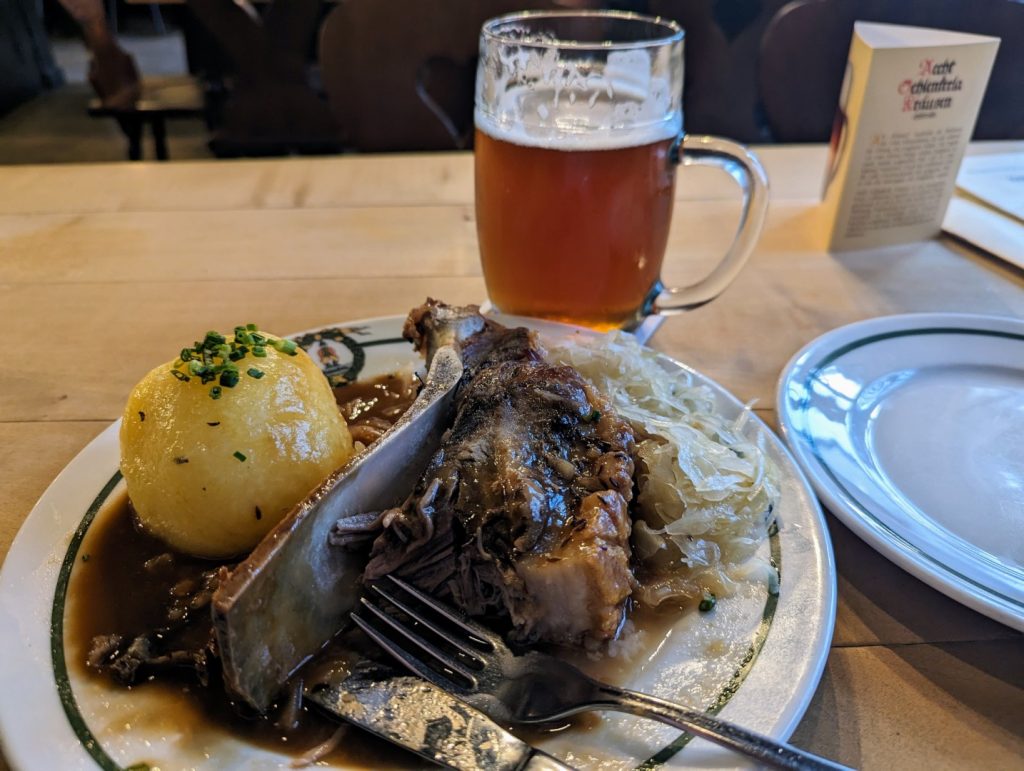
Local Bambergians (I may have just made up that term???) have been using smoked beer in their dishes for hundreds of years! It is actually a fantastic way to use some smoked beer to add a fantastic, well, obviously, smoked flavor to dishes! There are many historic dishes, but feel free to get creative! Here are some of the more traditional recipes:
Bamberg Zwiebel
Large onions, parsley, minced pork, bacon, rauchbier, mustard and seasonings make this home style Bamberg food! Here is a local recipe to try. Add a side of mashed potatoes and YUM!
Schäufele
One of my personal favorite dishes in Germany and an absolute staple in Bamberg is this perfectly roasted pork shoulder! Obviously, when the recipe suggests a dark beer for the gravy sauce, you can use a Rauchbier to add fantastic, smoky notes to the sauce! Try out this Schäufele recipe with smoked beer.
Schlenkerla Sausage
At the Schlenkerla Brewery, they have a unique take on the classic Bavarian sausage! They take the little wursts, which are a little bit sweet, and use the smoked malt itself right in the sausage! While typically. you’ll find sauerkraut on the side of wursts in Germany, these ones should come with a side of sweet cabbage.
Smoked Meat
My husband loves to smoke meat out in our smoker and anytime he makes any sort of homemade BBQ sauce or gravy to go with, the rauchbier is a great way to continue those smoked flavors into the sauce!
Smoked Beer Bread
You might have heard of beer bread before. What about trying a Rauchbier in it next time for a different take? Here is a typical beer bread recipe you can try (just use the Rauchbier instead) or if you’ve got a smoker you can really take it up the next level with this smoked beer bread recipe
FAQs
What German town is known for smoked beer?
Bamberg, Germany located in the upper region of Franconia in Bavaria is known for Rauchbier. It has the oldest, continuously working brewery to produce authentic and traditional Rauchbier.
What German beer tastes like smoke?
Rauchbier is literally “Smoke Beer” which is made from smoking the malt to create an incredibly unique flavor profile of a smoky beer.
Where to Buy Schlenkerla Beer
The Schlenkerla Brewery is located in Bamberg, Germany. However, Schlenkerla Rauchbier is now distributed world wide. You can find a Schlenkerla distributor near you here. You can also order Schlenkerla beer from their online store.





